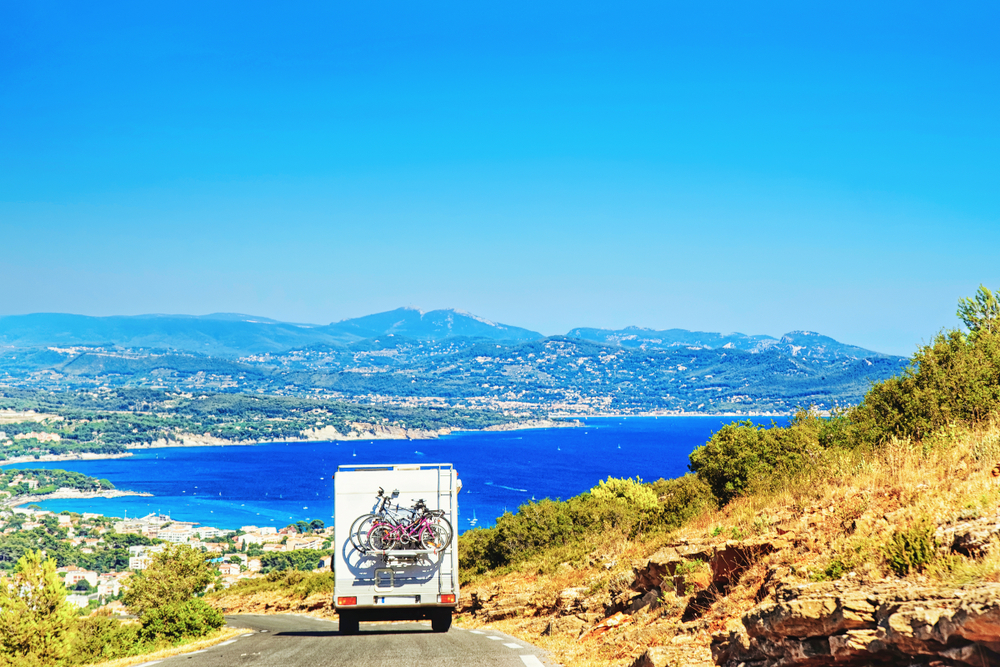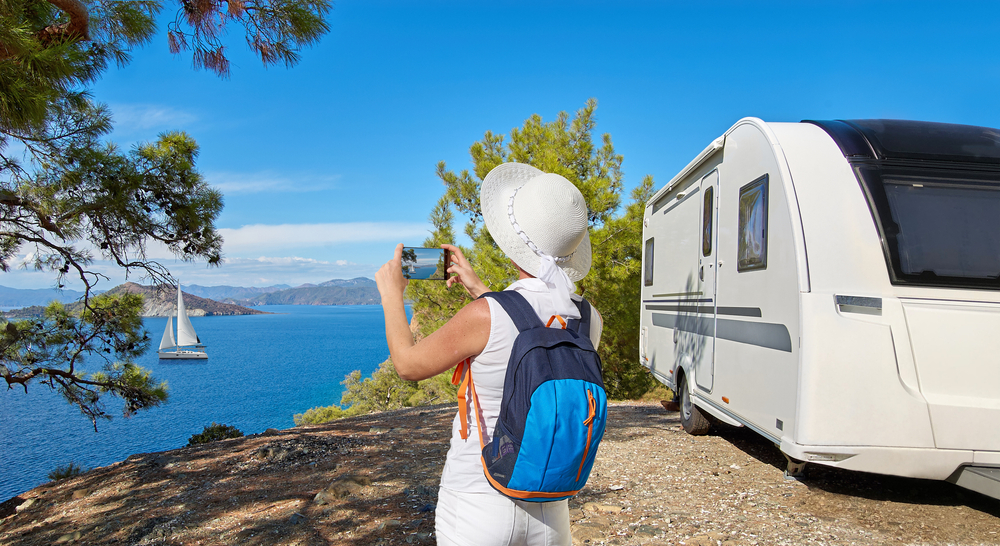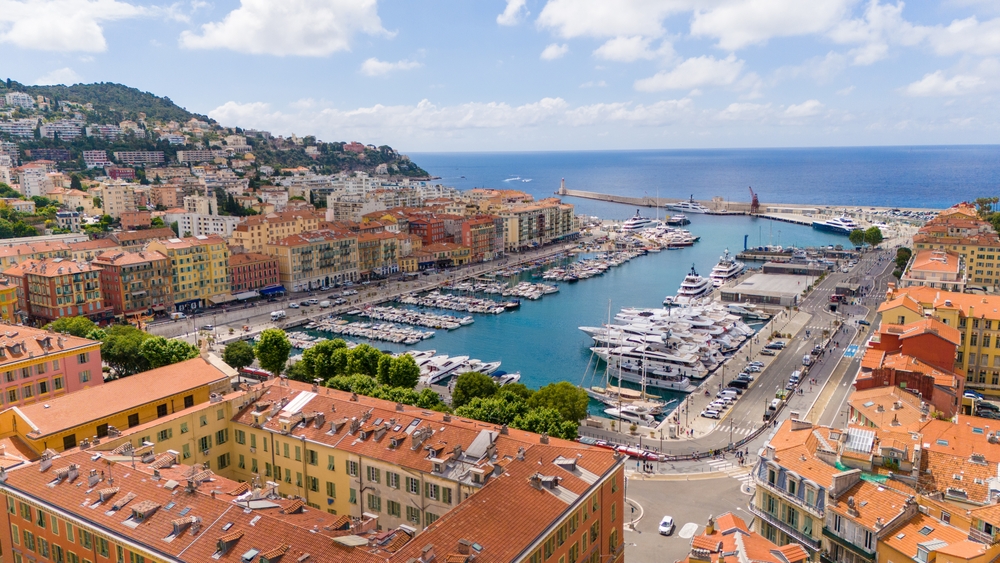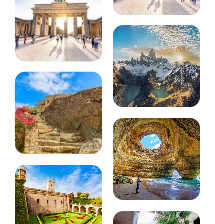
Discovering the Côte d’Azur in a motorhome: Tips and advice

Exploring the Côte d’Azur in a motorhome or converted van is an unforgettable getaway between sea and mountains, luxury and authenticity. From Nice to Menton, via Cannes, Antibes and Monaco, this emblematic region of southern France boasts breathtaking scenery, charming hilltop villages and dream beaches. Follow the guide to make the most of your road-trip on the French Riviera!

Also in the Nice guide:
- 26 must-do activities in the PACA region
- The best specialities in Nice
- Top 6 activities in Nice
- Top 6 best hotels in Nice
- The most beautiful beaches on the Côte d’Azur for swimming this summer
- The most beautiful river bathing sites on the Côte d’Azur
- Top 10 must-sees around Nice
- The 10 most beautiful beaches in Nice
1. Why choose a motorhome to discover the Côte d’Azur?
Travelling by motorhome on the Côte d’Azur gives you total freedom to explore this legendary destination at your own pace. No need to book accommodation in advance or plan each stage down to the day. You stop where you like, when you like, making the most of every moment. Between the turquoise sea and the hilltop villages of the hinterland, the panoramas are never the same.
Motorhoming also allows you to make substantial savings on accommodation, particularly appreciable in a region renowned for its high prices. You have your own space, your own kitchen, and can sleep facing the sea or in the heart of a Provençal village. It’s also an opportunity to visit Nice, discover the charm of Cannes or the elegance ofAntibes on your own.
2. The best motorhome itineraries on the Côte d’Azur

The west of the Côte d’Azur: from Toulon to Saint-Tropez
Start your journey in Toulon, gateway to the Côte d’Azur. This port town, with its rich naval past, is well worth a visit to climb to the top of Mont Faron and admire the harbour. Continue on to Bandol and its vineyards, then head for Hyères and its golden islands: Porquerolles, Port-Cros and Le Levant. These natural gems, accessible by boat from the Giens peninsula, offer heavenly beaches and unspoilt nature.
The Corniche des Maures will then take you to Le Rayol-Canadel and its exotic garden, before reaching Saint-Tropez, the unmissable seaside resort that has been the stuff of dreams for generations. Don’t miss the old port, the citadel and the Place des Lices for its legendary pétanque games. The Var hinterland is also full of authentic hilltop villages such as Ramatuelle and Gassin, offering spectacular views over the Mediterranean.
East of the Côte d’Azur: from Cannes to Menton
The Estérel massif marks the entrance to the Alpes-Maritimes, with its red rocks plunging into the blue of the Mediterranean. Fréjus and Saint-Raphaël are pleasant stops before arriving in Cannes, the capital of cinema. Download the audio-guided tour to discover Cannes on foot and let yourself be guided along the Croisette, the Palais des Festivals and the charming Suquet district. The Navaway application offers a complete itinerary so you don’t miss a thing of the city.
Grasse, the world capital of perfume, is well worth a diversion into the hinterland before heading back down to Antibes and Juan-les-Pins. These twin seaside resorts offer beaches, museums (including the famous Picasso museum) and a festive atmosphere. The hilltop village of Saint-Paul-de-Vence, a haven for artists, offers an enchanting cultural interlude. Nice, the capital of the Côte d’Azur, is the perfect place to discover thanks to a Navaway audio tour that will take you from the Promenade des Anglais to Vieux-Nice via the hill of the Château.
Monaco, a glamorous principality, and Menton, the pearl of France at the gateway to Italy, round off this tour of the Côte d’Azur in style. Don’t hesitate to explore all the tours available on Navaway to make the most of your visits.
The grand tour: a month on the Côte d’Azur
If you have three or four weeks, combine the above two itineraries and add a few trips into the hinterland: the Sainte-Baume Nature Park, the Valensole plateau and its lavender fields, the Verdon gorges for thrill-seekers, or the Préalpes d’Azur Nature Park. The Saint-Jean-Cap-Ferrat peninsula and the bay of Villefranche-sur-Mer offer exceptional panoramic views. Take the time to visit Nice in depth and explore the surrounding area.
3. Motorhome traffic and parking rules
The Highway Code applicable to motor caravans
On the Côte d’Azur, your motorhome is subject to the same rules as cars, as long as it does not exceed 3.5 tonnes. All you need is a driving licence, and the usual speed limits apply: 50 kph in town, 80 kph on secondary roads, 110 kph on expressways and 130 kph on motorways. However, beware of local restrictions, with some municipalities imposing 30 km/h zones or limiting access to certain areas.
The region is mountainous, so be extra vigilant on bends and corniche roads. The permitted blood alcohol level is 0.5 g/l. In the tight bends of the hinterland, don’t hesitate to honk your horn to signal your presence. The roads can be narrow, and prevention is better than cure.
Parking and unauthorised camping: what you need to know
Unauthorised camping is strictly forbidden in France, and the Côte d’Azur is no exception. You risk a fine if you park on the public highway to spend the night. During the day, motorhomes can park in conventional parking spaces, but beware: car parks often charge for parking and spaces are scarce, especially in the high season when more than 10 million overnight stays are recorded in the region every year.
If you’re travelling in a converted van, you’ll find it easier to go unnoticed than in a large motorhome, but there are police checks. For a peaceful night’s sleep, choose official motorhome parks, campsites or dedicated car parks. It’s easier to find quiet spots in the hinterland. If you park illegally, arrive late and leave early, and above all, never light a fire: with the wind and the Mediterranean vegetation, there is a real risk of fire.
4. The best motorhome parks on the Côte d’Azur

Finding a motorhome park on the Côte d’Azur requires a bit of organisation, especially in summer. The Park4night app proves indispensable: it lists service areas, campsites, free or paid car parks, and spots in the countryside. Users share their opinions and photos, making your search much easier.
Recommended areas in the Var
In Hyères, the Capte car park is ideally located close to the beaches and the departure point for the island shuttles. In Saint-Tropez, parking is complicated and expensive; prefer the areas in neighbouring communes such as Ramatuelle or Grimaud. The Toison d’Or campsite in Saint-Raphaël offers pitches for motorhomes with a view of L’Estérel.
Areas in the Alpes-Maritimes
In Cannes, free parking is available during the day at 25 Avenue du Docteur Raymond Picaud, opposite a basketball court. For overnight parking, use the nearby Mandelieu-la-Napoule car park. In Antibes, parking is difficult; the nearby Biot car park is a good alternative. If you’re visiting Nice, the Cagnes-sur-Mer car park, in the bus station and rotunda car parks, is an economical solution. In Monaco, the Stefano Casiraghi esplanade accepts vehicles less than 2.45 metres high.
The Camping-Car Park network also offers a number of serviced areas in the PACA region (water, electricity, drainage) with 24-hour access. You can expect to pay between €10 and €25 per night, depending on the season and the services on offer.
5. Budget for motorway tolls
The Côte d’Azur is criss-crossed by several toll motorways (A8, A50, A57, A500), managed by ESCOTA and VINCI. Prices are considerably higher than for a conventional car. Motorhomes are class 2, while converted vans are class 1.
A few examples of class 2 fares: Lyon/Marseille/Aix-en-Provence (A7-A8): €40.10, Aix-en-Provence/Nice (A8): €27.40, Sisteron Nord/Aix-en-Provence (A51): €18.80, Antibes/Aix-en-Provence (A8): €25.10. A round trip can therefore represent a substantial budget. To save money, opt for the departmental roads that run along the coast – they may be slower, but they’re so much more picturesque! You’ll be able to take in more of the scenery and stop off in the villages as you please.
6. Hire a motorhome to discover the Côte d’Azur
If you don’t own a motorhome, renting one from other people on platforms like Yescapa is an excellent solution. The principle is simple: choose your vehicle in the nearest town (Nice, Marseille, Toulon…), check that it offers unlimited mileage and the necessary number of berths, then make your request online.
If your application is accepted, you can arrange an initial meeting with the owner. On the big day, present your permit, pay the deposit, sign the rental contract after the inventory of fixtures, and off you go! On your return, a new inventory will validate the return. Remember to book in advance, especially during the summer months when demand is high. Rates vary according to the size, age and equipment of the vehicle, but you should expect to pay between €70 and €150 per day, depending on the season.
7. When should you go motorhoming on the Côte d’Azur?
The Mediterranean climate of the Côte d’Azur guarantees mild winters (10-15°C) and hot, dry summers (25-35°C). Summer may seem ideal for enjoying the beaches and warm sea, but it’s also the busiest and most expensive time of the year. Motorhome parks are full, prices soar and tourist sites are crowded.
Spring (April-May-June) and autumn (September-October) are the best times to travel by motorhome on the Côte d’Azur. Temperatures remain pleasant (20-25°C), mornings can be cool but days are sunny. Above all, you can avoid the crowds of tourists and still enjoy the region to the full. The hinterland is particularly good to visit at these times of year, with cooler temperatures at higher altitudes. In winter, the Côte d’Azur is appreciably milder, but some establishments and motorhome parks may be closed.
8. Not to be missed

Nice, the capital of the Côte d’Azur
Download the audio tour to discover Nice on foot and on your own. France’s fifth-largest city is well worth spending several days in. The Promenade des Anglais, Old Nice and its colourful streets, the Cours Saleya and its market, the hill of the Château offering an exceptional panorama of the Baie des Anges… Nice cultivates a unique art of living, combining French and Italian influences. The Matisse and Chagall museums will delight art lovers, while the port of Lympia and its ochre-coloured facades transport you to neighbouring Italy. Take advantage of the Navaway itinerary to visit Nice and make sure you don’t miss a single iconic site.
Cannes and its festival
Even outside the festival season, Cannes is well worth a visit. The Croisette and its legendary palaces, the Palais des Festivals and its pathway to the stars, the Old Port and the hilltop Suquet district offer a blend of glamour and Provencal authenticity. The Forville market delights the taste buds with local produce, while the Lérins islands, accessible by boat, offer an unexpected nature getaway. Let Navaway guide you through the streets of Cannes to discover all its secrets.
The hilltop villages of the hinterland
Eze, Saint-Paul-de-Vence, Gourdon, Peillon, Coaraze… These medieval villages clinging to their rocky outcrops offer breathtaking views of the Mediterranean. Cobbled streets, craftsmen, galleries, exotic gardens: each village has its own unique identity. Take the time to stroll around, savour a socca on a shady terrace and admire the work of local artists.
Monaco, a legendary principality
The Rock and its princely palace, the cathedral housing the graves of the Grimaldis, the oceanographic museum, the Monte-Carlo casino and its gardens… Monaco combines luxury, history and excess in just a few square kilometres. The changing of the guard in front of the palace at 11.55am is a popular free event. The Exotic Garden offers an extraordinary bird’s-eye view of the principality.
9. Practical tips for a successful road trip
Anticipate water supply and drainage needs
Service areas for motor caravans allow you to fill up with drinking water and empty grey and black water. On the Côte d’Azur, they are well distributed but can be saturated in high season. Always make sure you have enough water in advance and drain regularly. Some areas are free, while others charge between €2 and €5 for the service.
Managing electricity and gas
When you’re camping or in a serviced area, you can plug into an electrical socket. When you’re not parking, your auxiliary battery will take over for lighting and small appliances. A solar panel is very useful for autonomy. For gas, always take a spare bottle with you, as LPG stations are rare on the Côte d’Azur.
Adapting your driving to the terrain
The roads inland are narrow and winding. Take your time, respect the indicated gauges (height, width) and don’t hesitate to stop to let vehicles pass through tricky sections. When driving downhill, use the engine brake rather than the brakes to avoid overheating. Check your mirrors regularly, especially on tight bends.
Respecting the environment
The Côte d’Azur is a fragile area, particularly exposed to the risk of fire. Never throw cigarette butts out of windows, never light fires in the open, and respect the restrictions on access to the massifs during periods of high fire risk. Sort your rubbish and use the collection points. Avoid parking on private land or in protected natural areas.
10. Gastronomic specialities to discover en route

A road-trip on the Côte d’Azur is also a culinary journey! Don’t miss the socca niçoise (chickpea pancake), the pissaladière (onion, anchovy and olive pie), the farcis, the ratatouille, the daube provençale or the bouillabaisse. Provençal markets are full of local produce: olive oil, tapenade, goat’s cheese, candied fruit, calissons d’Aix…
On the sweet side, try ganses (Nice doughnuts), fougasse, oreillettes or tourte de blettes (although the name may come as a surprise!). Serve with a chilled Provence rosé or Bellet, a wine produced in the hills above Nice. Artisanal ice-cream makers offer original flavours such as orange blossom, calisson and violet.
In conclusion, the Côte d’Azur by motorhome offers an incomparable travel experience, combining freedom, discovery and authenticity. With its dream beaches, hilltop villages, iconic towns and unspoilt hinterland, every day has its share of surprises in store. Don’t forget to plan your itinerary, look out for parking areas and download the Navaway tours to make the most of every stopover. Whether you’re away for a week, two weeks or a month, the French Riviera promises unforgettable memories at the wheel of your home on wheels. So, are you ready to hit the road?
FAQ : Your questions about the Côte d’Azur in a motorhome
Can I park my motorhome for free on the Côte d’Azur?
Free parking is available but is rare, especially on the coast. During the day, you can park in conventional spaces in non-paying areas. For overnight stays, it’s best to use the pay-and-display motorhome parks or move away from the coast towards the hinterland, where there are more possibilities. Please note that unauthorised camping is prohibited and punishable by fine.
How long does it take to visit the Côte d’Azur in a motorhome?
Allow at least a week to explore the main coastal towns. Two weeks will also allow you to explore the hinterland and take time to enjoy the beaches. A month or more will give you the chance to explore the whole region, discover the hilltop villages, go hiking and soak up the Côte d’Azur way of life.
Do I need special equipment to travel in a motorhome on the Côte d’Azur?
As well as the standard equipment for your motorhome, you’ll need sun protection (blinds, curtains), air conditioning or at least a fan for the summer, plenty of water and a good GPS with size restrictions. An electric bike can come in handy for visiting city centres without looking for a parking space. The Park4night app is essential for finding parking spaces.
Is it possible to travel in a motorhome on the Côte d’Azur with children?
Absolutely! The motorhome is ideal for travelling with the family. Children have their own space, you can manage meals and naps at your own pace, and the region offers plenty of family activities: beaches, water parks (Marineland in Antibes), fun museums and nature walks. Just remember to keep the inside of the motorhome secure and take regular breaks during the journey.
200 audioguided tours for cities all around the world
Download
